Characteristics:
Displacement:
|
970 tons
|
Dimensions:
|
55.31 x 11.30 x 3.4 meters (181.5 x 37 x
11 feet)
|
Propulsion:
|
Diesel-electric;
4 diesels
2 Z drives driven by electric motors
15 knots
|
Crew:
|
31-36
|
Sonar:
|
sidescan (as modular package)
|
Countermeasures:
|
7 modular payloads;
route survey (4)
mechanical minesweeping (2),
bottom inspection (1)(West Coast)
|
Armament:
|
1 40mm single Bofors gun
2 12.7 mm machine guns
|

Ships:
|
Name
|
Pendant
|
Commissioned
|
Homeport
|
|
KINGSTON
|
700
|
21/09/96
|
Halifax
|
|
GLACE BAY
|
701
|
26/10/96
|
Halifax
|
|
NANAIMO
|
702
|
10/05/97
|
Esquimalt
|
|
EDMONTON
|
703
|
21/06/97
|
Esquimalt
|
|
SHAWINIGAN
|
704
|
14/06/97
|
Halifax
|
|
WHITEHORSE
|
705
|
17/04/98
|
Esquimalt
|
|
YELLOWKNIFE
|
706
|
18/04/98
|
Esquimalt
|
|
GOOSE BAY
|
707
|
26/07/98
|
Halifax
|
|
MONCTON
|
708
|
12/07/98
|
Halifax
|
|
SASKATOON
|
709
|
05/12/98
|
Esquimalt
|
|
BRANDON
|
710
|
05/06/99
|
Esquimalt
|
|
SUMMERSIDE
|
711
|
18/07/99
|
Halifax
|

Notes:
This design dates to the 1980's, when it was apparent that the
then-current fleet of training ships were in desperate need of
replacement.
Also, it was necessary to reclaim some of the mine countermeasures
capability that had been lost since WWII in the Canadian Navy.
Therefore, the KINGSTON class of MCDV's (Maritime Coastal Defence
Vessels) was ordered. They are largely being manned by the Naval
Reserves, and provide valuable training for the reserves while freeing
up regular force personnel for other duties. These ships carry out a
multitude of missions, including coastal patrol, light mine
countermeasures, route surveys, ROV handling, and will take on some of
the duties formerly carried out by the fleet dive tender, HMCS
CORMORANT.
As a cost saving measure, the KINGSTON class are largely built
to civilian standards. When first launched, it was discovered that
these ships suffered from a slight list: this problem was corrected by
the addition of extra ballast. The ships have a diesel - electric
propulsion system which drives two azimuth, or Z-, drives. These are
two fixed pitch propellers situated side-by-side at the stern, rather
like two outboard motors, each which can rotate a full 360 degrees.
This makes these ships extremely maneuverable. Many ships have been
send far afield, with some taking part in exercises in Europe. However,
they are not designed for open ocean transits, and it was discovered
that they had a tendency to hull-slam in heavy seas. Some research has
been done to look into modifications to the control system that will
reduce the severity of this problem.
The various payloads (for minesweeping, ROVs, sidescan sonar,
etc) for these ships are modular, meaning that they can be embarked and
disembarked with relative ease, and moved from ship to ship as
required. There are not enough payload packages to equip all the ships
at one time. The guns carried by these ships are Second World War
surplus, and are very limited in capability. These guns have been in
the Navy for many years, serving on such ships as the PRESTONIAN class
ocean escorts, TRIBAL class and ST. LAURENT class destroyers, Bay class
minesweepers, Porte class gate vessels, and in Europe on airbases for
anti-aircraft defence.

Photos:
(click on thumbnail for bigger image)
|
KINGSTON
|
|
Notes:
|
1. KINGSTON entering
Bedford
Basin. (2001)
2. A detailed profile of a KINGSTON class MCDV.
3. KINGSTON on the Halifax waterfront. ('96) Stacey Hare photo.
4. KINGSTON in Halifax Harbour. (03/98) Sandy McClearn photo.
5. KINGSTON passes McNab's Island as she enters Halifax Harbour. Sandy
McClearn
photo.
6. KINGSTON lowers a RHIB into the water. Sandy McClearn photo.
|
|
1
|
2
|
3
|
4
|

|

|

|

|
5
|
6
|
7
|
8
|

|

|
|
|
|
|
|
|
NANAIMO
|
|
Notes:
|
1. NANAIMO outside
Esquimalt. DND photo.
2. NANAIMO in Halifax Harbour in 1996; she has not yet been fitted with
her
Bofors gun. Sandy McClearn photo.
|
|
1
|
2
|
3
|
4
|

|

|
|
|
5
|
6
|
7
|
8
|
|
|
|
|
|
|
EDMONTON
|
|
Notes:
|
1. HMCS EDMONTON in
Halifax Harbour. DND photo.
|
|
1
|
2
|
3
|
4
|

|
|
|
|
5
|
6
|
7
|
8
|
|
|
|
|
|
|
SHAWINIGAN
|
|
Notes:
|
1. SHAWINIGAN in Halifax
Harbour.
Sandy McClearn photo. (2001)
2. SHAWINIGAN at HMC Dockyard. Sandy McClearn photo. (03/97)
3. SHAWINIGAN enters the narrows of Halifax Harbour. Sandy
McClearn photo.
4. Passing HMCS IROQUOIS, undergoing a refit at the Halifax Shipyard.
Sandy
McClearn photo.
5. A Glen class tug tows SHAWINIGAN past HMCS PRESERVER towards Bedford
Basin.
Sandy McClearn photo.
|
|
1
|
2
|
3
|
4
|

|

|
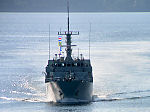
|
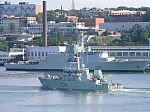
|
5
|
6
|
7
|
8
|
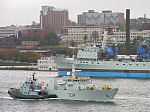
|
|
|
|
|
|
WHITEHORSE
|
|
Notes:
|
1. WHITEHORSE on the
slip in Liverpool, NS. (04/97) Sandy McClearn photo.
2. The Z-drives on WHITEHORSE. (04/97) Sandy McClearn photo.
3. WHITEHORSE again. (04/97) Sandy McClearn photo.
4. Bow view of WHITEHORSE on the slip. (04/97) Sandy McClearn photo.
|
|
1
|
2
|
3
|
4
|

|

|

|
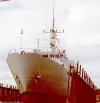
|
5
|
6
|
7
|
8
|
|
|
|
|
|
|
YELLOWKNIFE
|
|
Notes:
|
1. YELLOWKNIFE in
Vancouver,
BC. Rob Blair photo.
|
|
1
|
2
|
3
|
4
|

|
|
|
|
5
|
6
|
7
|
8
|
|
|
|
|
|
|
GOOSE BAY
|
|
Notes:
|
1. GOOSE BAY during the
winter of 1998. Sandy McClearn photo.
2. GOOSE BAY lies at anchor in front of HRC Dockyard in Halifax. Sandy
McClearn
photo.
3. GOOSE BAY at sunrise. (2008) Sandy McClearn
photo. |
|
1
|
2
|
3
|
4
|

|

|
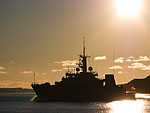
|
|
5
|
6
|
7
|
8
|
|
|
|
|
|
|
MONCTON
|
|
Notes:
|
1. MONCTON. Sandy
McClearn photo. (April 2003)
2. Sandy McClearn photo.
3. Sandy McClearn photo.
4. MONCTON passes a large container ship in Halifax Harbour. Sandy
McClearn
photo.
|
|
1
|
2
|
3
|
4
|

|
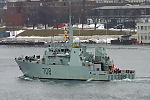
|
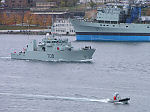
|

|
5
|
6
|
7
|
8
|
|
|
|
|
|
|
SASKATOON
|
|
Notes:
|
|
|
1
|
2
|
3
|
4
|
|
|
|
|
5
|
6
|
7
|
8
|
|
|
|
|
|
|
BRANDON
|
|
Notes:
|
1. BRANDON slides down
the
launchway at the Halifax Shipyard. DND photo.
|
|
1
|
2
|
3
|
4
|
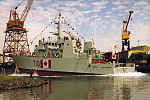
|
|
|
|
5
|
6
|
7
|
8
|
|
|
|
|
|
|
SUMMERSIDE
|
|
Notes:
|
1. SUMMERSIDE. Sandy
McClearn photo. (March 2003)
2. Same as 1.
3. Appearing attached at the stern, SUMMERSIDE and KINGSTON (last and
first of the class respectively) are tied up alongside stern to stern.
(2002)
4. SUMMERSIDE. (2001)
5. SUMMERSIDE passes an iceberg. DND photo.
|
|
1
|
2
|
3
|
4
|

|

|

|

|
5
|
6
|
7
|
8
|

|
|
|
|
|
|

